Aquaculture and Biological Interactions Research at SABS
Station scientists use a multi-disciplinary approach to enhance the economic and environmental sustainability of the Canadian aquaculture industry. In Southwest New Brunswick, salmon aquaculture is a major economic player. Station research includes studying the progression and transmission of fish diseases and pathogens; multi-trophic aquaculture to minimize environmental effects and provide alternate species for harvest; studying the interactions of aquaculture with wild species and ecosystems; and oceanographic monitoring to provide advice for site location and reduction of disease transfer.
Aquaculture and lobster interactions
In 2016, a Program for Aquaculture Regulatory Research project was initiated between Maurice Lamontagne Institute and the St. Andrews Biological Station to investigate the behaviour of lobsters in the vicinity of salmon farms in the Passamaquoddy Bay area of southwest New Brunswick.
Using a combination of trapping and diving, a total of 108 lobsters and crabs were fitted with a transmitter and released on one of the two farm sites at which a grid of 30 acoustic receivers were placed. The transmitter from each animal sent out a signal every 3 minutes that the grid of receivers recorded for time and position. This gear setup was left in place for 4 months and allowed the researchers to follow the detailed movements continuously for each individual.
While analysis of the data are continuing, preliminary results are showing that the lobsters and crabs seem to stay in the vicinity of the salmon farms and have very well defined home ranges that are not that affected by the farm itself.
For more information on this project.

Transmitters externally attached to lobster
Aquaculture and wild Atlantic salmon interactions
Fisheries and Oceans Canada is committed to improve our understanding of wild Atlantic salmon interactions and the aquaculture industry to make better informed regulatory decisions. Biological Station scientists have begun a pilot project using acoustic tags to better understand the interactions between ocean migrating wild Atlantic salmon and their marine environment, in particular with salmon aquaculture sites and predation pressure in the Bay of Fundy. The long-term goal is to determine stage specific mortality in estuaries and in the ocean, and where and how much time wild salmon may spend near aquaculture sites in the Maritimes Region to better understand the exposure time and interactions of wild salmon to salmon aquaculture.
In its first year, 60 wild salmon smolts from DFO’s Mactaquac Biodiversity Facility were implanted with acoustic tags and released below the dam on the Magaguadavic River estuary in St. George, New Brunswick. Twenty-nine receivers that pick up transmissions from these tags were placed at active and inactive aquaculture sites as well as in the Magaguadavic River estuary and at exit points to Passamaquoddy Bay. After 20 days, the tags in the fish switched to a low emission mode to allow for longer term tracking and to provide information on survival estimates in specific habitats. As well, should the fish leave the Passamaquoddy Bay area, they will signal to receivers operated by the Ocean Tracking Network to provide additional information on their survival and migration. This work is done with support from the aquaculture industry, the Atlantic Salmon Federation, the Ocean Tracking Network, National Oceanographic Atmospheric Administration (NOAA) Fisheries, and is funded under the department’s Aquaculture-Ecosystem Interactions Program.
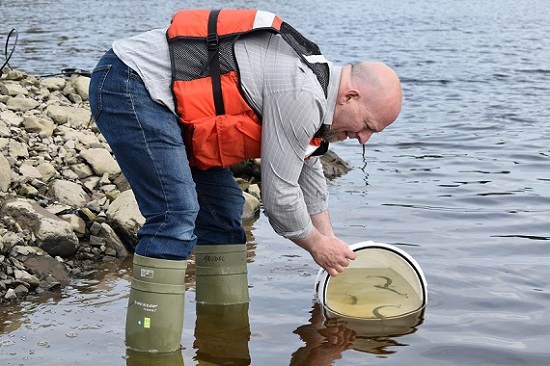
Dr. Trudel releases tagged Atlantic salmon smolt into the Magaguadavic River estuary
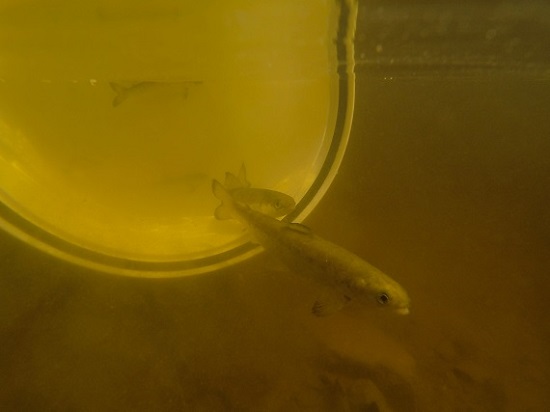
Underwater view of Atlantic salmon smolt released into estuary
Disease Research
The Biocontainment Laboratory at the Saint Andrews Biological Station is used by government scientists to study animal health issues and to provide scientific advice in support of policy development and regulatory activities. Current research projects investigate genetic traits linked to disease and parasite susceptibility to ensure healthy, disease-resistant adults (brood stock) are being used by the salmon aquaculture industry. Research to improve knowledge of recently identified disease agents and to better understand the risk of spreading disease from farms to the environment is ongoing.
These projects include research on Infectious Salmon Anaemia virus (ISAv) and the bacterial pathogens responsible for ‘mouth rot’ and bacterial kidney disease (BKD). The goal of these projects is to develop solutions that will result in a reduced need for antibiotics and reduced risk of disease transfer. These research projects support both the sustainability of aquaculture and the survival of wild salmon populations.
ISAv (Infectious Salmon Anaemia virus) can cause high mortality in Atlantic salmon and can result in significant losses to aquaculture operators. Current vaccines do not provide 100 percent protection, therefore, farm management and surveillance methods are used to reduce the risk of outbreak. One project is studying the minimum exposure to the ISA virus required to cause disease and measuring the amount of virus released by infected fish. As well, the impact of the virus on the physiology and fitness of fish that survive exposure is being investigated.
A bacteria called Tenacibaculum spp. causes a condition called ‘mouth rot’ or tenacibaculosis. This study aims to develop an infection model to study the progression of disease, to test potential treatments and to explore interactions among bacteria associated with skin ulcers.
Developing disease resistance among commercial Atlantic salmon populations is a means to improve conditions for farmed fish and to reduce environmental interactions including farm-wild interactions for salmon. It is well-known that there is significant family-associated variation amongst salmon with respect to resistance to disease. Family crosses of salmon from industry partners’ broodstock program are being tested for resistance to a disease and parasite of concern with the goal to identify susceptible and resistant families to aid in the development of genetic tools.
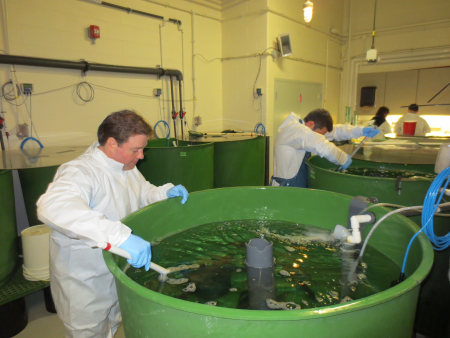
Research on Atlantic salmon health issues are studied at SABS
Sea Lice Research
Sea lice are a naturally occurring crustacean parasite that attach themselves to a fish host, such as Atlantic salmon. These parasites have co-evolved with their hosts for millions of years and, as a result, they are very good at finding a host, particularly when the hosts are in high concentrations, such as salmon in sea cages.
Sea lice infestation or outbreaks, which have been a recurring problem in salmon aquaculture over the last two decades, must be managed with treatments to maintain animal health. These infestations are a significant cost for the industry and are of concern for their potential impacts on the marine environment. Evidence shows that sea lice can develop resistance to existing chemical treatments, which is similar to land-based pests that impact the agricultural industry.
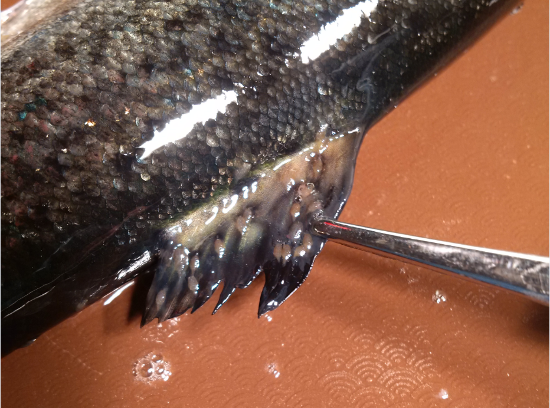
Sea lice are a naturally occurring crustacean parasite that attach themselves to a fish host, such as Atlantic salmon.
For salmon farming in coastal waters, it is still not clear how the larval planktonic sea lice complete their life cycle. After being released from their mother’s egg sac, the tiny, slowly swimming larvae drift away but are somehow able to find their way back to a salmon farm despite the large volumes of sea water that pass through the site.
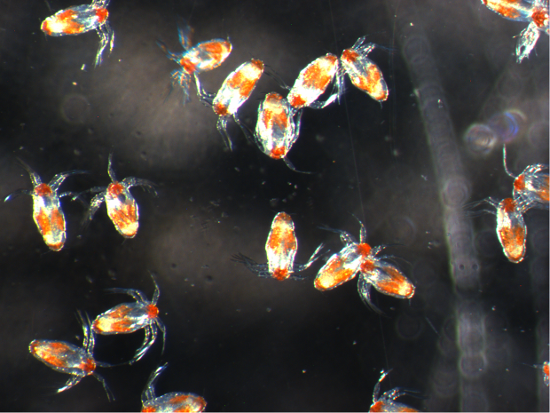
Larval sea lice, or nauplii, as seen under a microscope.
With funding from the Aquaculture Collaborative Research and Development Program, Station researchers are:
- studying the distribution and infestation dynamics of sea lice on salmon farms;
- testing green technologies based on mechanical strategies of removal to reduce dependence on chemicals for control and removal of sea lice from salmon; and
- working with industry to develop methods, such as warm water showers, to remove and capture the lice to reduce their occurrence at cage sites and to try and break the cycle of infestation.
This research will provide scientific advice on options for improved farm-management activities and sea lice treatment approaches that help minimize the potential for harmful environmental impacts.
Early indications suggest that the effectiveness of the warm water shower to remove sea lice from adult salmon, and then capturing the lice with filters, may significantly reduce their ability to re-infest the farm site. However, there is concern that sea lice may develop a resistance to warm water similar to the resistance that has developed to chemical treatments. Unfortunately, simply increasing the water temperature of the shower is not possible due to potential negative effects on the welfare of the fish. Researchers are studying whether sea lice can develop a resistance to the warm water shower by selectively raising generations of sea lice that have been exposed to higher temperatures. Should the sea lice show signs of adapting, it will provide further information on the effectiveness of the warm water shower technology.
Our researchers have also been studying the potential to select Atlantic salmon broodstock (fish that are mated to produce offspring) that are more resistant to sea lice infection. The goal is to allow industry to determine genetic markers that may be linked to better resistance, and develop broodstock that will produce offspring that are better at resisting sea lice infection.
Additionally, work is underway to test whether sea lice removal behaviour in Lumpfish, a natural cleaner fish, can be passed on from generation to generation. If so, the potential for using these fish as a natural control of salmon lice may become more efficient and help reduce the need for chemical treatment of the pest.
For more information on these projects, please visit the Aquaculture Collaborative Research and Development Program.